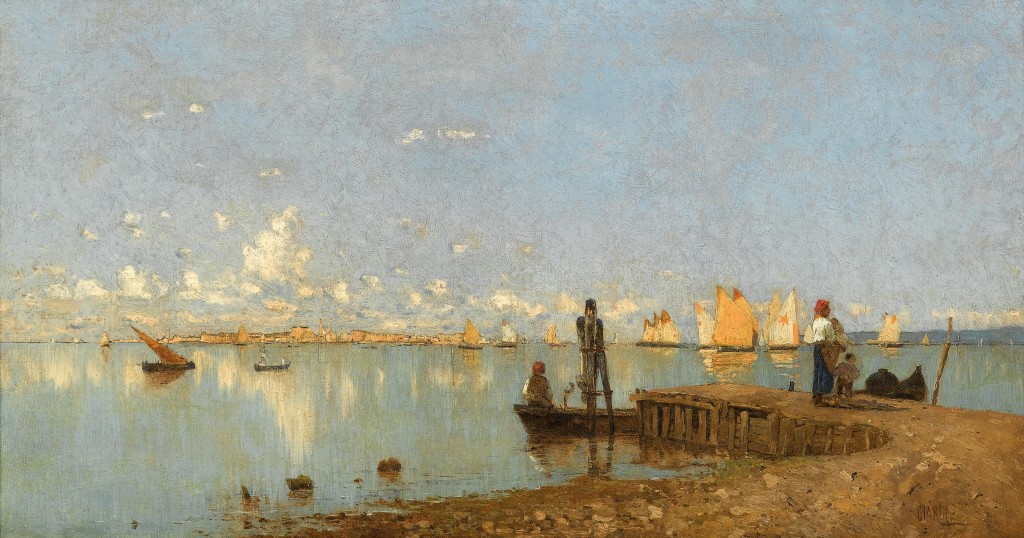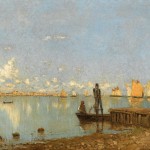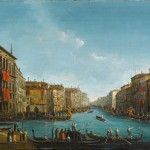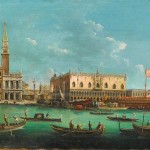The popularity of Venice views in the 19th century was rooted in the Grand Tour phenomenon, which had begun over a century earlier. Wealthy young men from North European countries would set out for Italy as a culmination of their classical education.
During the 18th century the demand for views of Venice had been satisfied by such famous artists as Canaletto and Guardi. The tradition of view painting was carried on in the early and mid-19th century by Ippolito Caffi (1809–1866). His moonlit view, for instance, captures the mysteriousness of Venice at night (lot 1117). Considering the popular nature of the painting’s subject matter, it is not surprising that Caffi addressed the theme on several occasions. There are three other versions of the work in public collections including the Ca’ Pesaro Museum of Modern Art, the Civic Museum of Belluno and the Revoltella Museum in Trieste.
Caffi was admitted to the Accademia of Venice in 1827 and emerged as an eminent landscape painter. He stayed in Rome from 1832 to 1848 but returned to Venice on many occasions, representing both cities with vivid colors and shifting light.
Venice was a commercial subject for many artists who were attracted by its intrinsic beauty and luminosity. The increased demand for souvenir views of a newly rich bourgeoisie found a ready market for many artists in the 19th century.

Another important figure in Venice was Guglielmo Ciardi (1842–1917). Throughout his career, Ciardi (lot 1152) depicted the city of Venice many times. His fascination with Venice, its architecture and inhabitants never diminished. He was one of Italy’s most faithful adherents to plein air painting. Ciardi trained at the Academy of Venice under the landscape painter Domenico Bresolin (1814–1890) and absorbed new influences from study trips around Italy. It was in Florence with Silvestro Lega (1826–1895) and Telemaco Signorini (1835–1901), in Rome with Nino Costa (1826–1903), and in Naples with Domenico Morelli (1823–1901) that he discovered his passion for plein air painting, which became central to his art. After returning to Venice for good, he sought to capture the atmosphere of the lagoon for the rest of his life.
The present lot confirms Ciardi’s talent for capturing light with perfection. His brushstrokes depicting the water are downright modernist. The lagoon attracts our first gaze as the light is reflected by the water. The masts with their colored sails seem to be moving to the rhythm of the water. On the right-hand side a mother is standing with her two children against the backdrop of the city of Venice.

Giuliano Zasso’s (1833–1889) color palette and lively composition – mostly celebrating daily life in Venice – was very popular with tourists who visited the city. The work coming up for auction depicts local people including elegantly dressed women and a child engaged in some playful occupation, possibly feeding pigeons (lot 1108).
Other important Venetian paintings in the Old Masters auction on 19th April include two works by Giuseppe Bernardino Bison (lot 98 and lot 99) and a view of the Grand Canal by Michele Giovanni Marieschi (lot 100).
(myART MAGAZINE Nr. 07/2016)
Auction 19th Century Paintings
Thursday 21st April 2016, 5 pm, Information: Experts in 19th Century Paintings
Auction Old Master Paintings
Tuesday 19th April 2016, 5 pm, Information: Experts in Old Master Paintings
Viewing from Saturday 9th April 2016
Palais Dorotheum
Video: 19th Century Paintings Preview


















